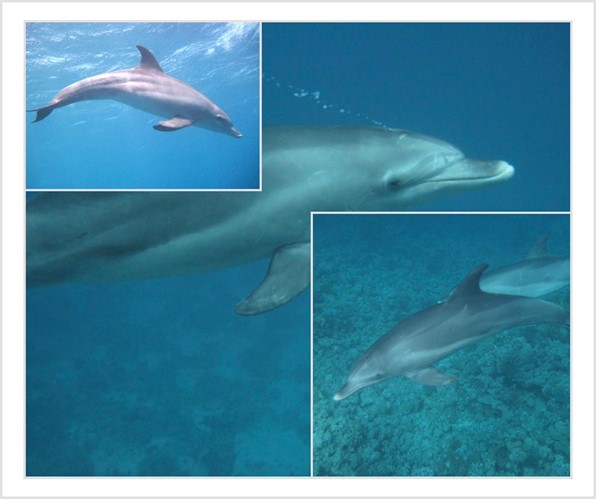Dolphin Facts

Some of our lucky divers had the wonderful experience of sighting dolphins whilst underwater recently on Jackfish Alley and on Shark Reef & Yolanda so we thought we would give you a few facts about dolphins.
Dolphins Are Carnivores
Dolphins work as a team to capture their food, surrounding and circling their prey and continuing to circle until the prey is forced into a tight ball allowing them to easily capture the fish that can’t escape.
They are often seen using sponges to help them forage for food, holding the sponge in their snout and using it to protect their sensitive noses whilst searching for prey on the sea floor. They also have other group hunting strategies like kicking up a lot of the mud or sand in the bottom of the water to camouflage themselves from the fish and make a net of sorts.
They have excellent eyesight, but often hunt in areas that are murky or dim so they use echolocation to navigate and locate the food, sending a series of click noises and waiting for the echo to return. These clicking sounds can tell the size, shape, distance and even the direction an object is travelling
Although they do have teeth most of them don’t use them to chew their food instead they swallow it whole, head first, so the scales on the food do not irritate their throat. They use their teeth to defend themselves and to grip objects. They actually have two stomachs: one for food storage and one for digestion.
Keeping one eye open at all times !!
We as humans go into an unconscious sleep –we are able to do this as we have a reflex that keeps us automatically continuously breathing where as a dolphin does not have this reflex and must remain conscious at all times. So to be able to breathe Dolphins and whales sleep in an unusual way, called “unihemispheric slow-wave sleep,” it basically means that they sleep with only half of their brain. When a dolphin goes to sleep, it shuts down one side of its brain and closes the opposite eye. If they should fall into an unconscious sleep they would suffocate.
Over a 24-hour period, each side of a dolphin’s brain gets about 4 hours of sleep. They can continue to slowly swim whilst sleeping. This form of sleeping allows half their brain to control their breathing and watch out for danger, also allowing muscle movement to continue to maintain body heat.
Circle of life
The rings inside the tooth of a dolphin can be used to determine their age; each growth ring is a year of life.
The life expectancy of dolphins varies, but the common bottlenose dolphin can live a whopping 20 to 50 years!
Killer whales are actually large dolphins!
The name killer whale came from ancient sailors who observed orcas hunting and preying on other whale species. They called them “asesina ballenas” which translates to whale killer. Eventually, the names were flip-flopped and the term killer whale was born.
Orcas are the largest members of the dolphin family
Dolphins sometimes have hair
Dolphins have a few sparse hair follicles but any hairs that are present fall out before or quickly after birth. They don’t have any sweat glands either to cool, but during prolonged exercise or in warm water, a dolphin may need to shed excess heat. Their circulation increases to blood vessels near the surface of the flippers, flukes, and dorsal fin, and decreases to blood vessels circulating blood to the body core. Excess heat is shed to the external environment
Deep Diving
Most dolphins can stay underwater for 8 to 10 minutes to depths of 3-46 m but the deepest recorded dive was to 492 m. They breathe through a blowhole that gets covered by a muscular flap when they go under the water. This keeps any water from getting into their lungs.
Dolphins also use selective circulation when they dive. The blood flow to their skin, digestive system, and extremities slows down or stops when they go underwater. Their heart, brain, and tail can still function.
Dolphin Skin Is Especially Vulnerable to Environmental Elements
Dolphin skin is very unique it is soft and smooth and feels kind of like a slippery river rock. This softness comes from how quickly the skin cells are able to regenerate on the surface of the dolphin. They slough off their skin all of the time and can regenerate it in as little as two hours.
Since dolphin skin cells are so active, they also react a lot to pollutants. there is evidence that bottlenose dolphins are being exposed to chemical compounds from consumer products. These chemicals are known to cause cancer in humans.
If you care about dolphins, then you should take as many steps as you can to reduce your plastic use and avoid putting harmful chemicals into the environment. These magical creatures are not able to protect their own homeland, and it’s up to us as humans to realize what we are doing to their environment before they become extinct.
Social Skills
Dolphins are known to be playful and curious and often seen riding the waves or playing at the bow of a boat. They are also helpful to each other, if a dolphin is injured they have been seen to work together and help get it to the surface to breathe.
So far scientists are unsure if dolphins mourn their dead but this complex emotion is likely of them and many have been seen showing signs that this may be true – infact some of our own guides came across a dolphin that looked like it had been placed carefully in a crevice in the wall of Shark Observatory as though it had been placed carefully there.
Every Dolphin Has a Signature Whistle so Others Can Recognize It
Each dolphin has a distinct whistle that signals their presence to other dolphins, just like how we have names to recognise who we are talking to. Some studies have suggested that they may have a unique form of language and are capable of complex communication with each other


